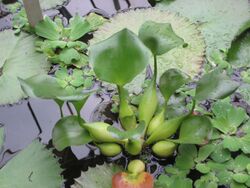Biology:Nymphaea lotus f. thermalis
| Nymphaea lotus f. thermalis | |
|---|---|

| |
| In foreground: Eichornia crassipes;
in background: flat leaves of Nymphaea lotus and Pistia stratiotes | |
| Scientific classification | |
| Kingdom: | Plantae
|
| (unranked): | |
| Order: | |
| Family: | |
| Genus: | |
| Species: | |
| Form: | N. l. f. thermalis
|
| Trinomial name | |
| Nymphaea lotus f. thermalis (DC.) Tuzson
| |
Nymphaea lotus f. thermalis (sometimes referred to as Nymphaea lotus var. thermalis)[1] is a form of Nymphaea lotus (commonly called the tiger lotus, white lotus or Egyptian white water-lily) in the genus Nymphaea.[2] Whilst some authorities list Nymphaea lotus f. thermalis as being synonymous with N. lotus,[3] others list it as a distinct taxon[4][5] – further investigation is required to determine its precise classification.[6] The usual habitat for Nymphaea lotus is the Nile Delta, hence Nymphaea lotus f. thermalis's Romanian habitat is unusual.[6]
Description
Nymphaea lotus f. thermalis is a water lily which blooms at night[6] – its flowers last four days and have four sepals, 19–20 white petals along with yellow anthers and stamens.[7] There is usually a 15–30 cm gap between flowers and the surface of the water, flowers are slightly fragrant; the round leaves of the plant are 20–50 cm wide.[7] A description was first formally published in Math. Természettud. Értes. 25(4):32, 36. 1907.[2]
Habitat
Nymphaea lotus f. thermalis is endemic to the thermal water of the Peţa River, Sânmartin, Bihor County, Romania.[6] The area is protected as a nature reserve (51.0 hectares (126 acres) in size) and consists of a rivulet along with three ponds. The water has a roughly constant temperature of around 30 °C whilst the site has an average air temperature of 10–11 °C.[6] The thermal waters have been recorded as early as 1211, but it was only in 1799 that the first record of N. lotus was made, by Pál Kitaibel.[6][8] Janos Tuzson proposed in 1907 that this population's unusual location could be explained by the persistent heat provided by the thermal springs could have sustained the population at a pre-ice age time when the plant would have been spreading across the warmer regions of Europe; this theory was corroborated by additional evidence provided by the identification of other endemic species.[6][9] Alexandru Borza was the Government minister in charge of education (and also a botanist) who made the first push for legal protection and recognition of Nymphaea lotus f. thermalis – in 1932, the Cabinet of Romania declared the rivulet a nature reserve and the plant a "national monument".[6] Conservation action with the intent to preserve this population has been undertaken for many years (since at least 1940) – including the management of invasive species – and the plant has been included in recent water management legislation.[6]
Whilst not held in any Romanian botanical gardens, Nymphaea lotus f. thermalis is grown at Royal Botanic Gardens Kew and at the botanic garden of Bonn University.[6]
References
- ↑ "Synonyms of Nymphaea lotus f. thermalis". Archived from the original on 11 August 2014. https://web.archive.org/web/20140811131013/http://eol.org/pages/5472837/names/synonyms. Retrieved 9 August 2014.
- ↑ 2.0 2.1 "Nymphaea lotus f. thermalis". GBIF. Archived from the original on 9 August 2014. https://web.archive.org/web/20140809145453/http://www.gbif.org/species/4940234. Retrieved 9 August 2014.
- ↑ {{citation | mode = cs1 | title = Nymphaea lotus f. thermalis | work = Germplasm Resources Information Network (GRIN) | url = https://npgsweb.ars-grin.gov/gringlobal/taxonomydetail.aspx?415837 | publisher = [[Organization:Agricultural Research ServAgricultural Research Service (ARS), United States Department of Agriculture (USDA) | access-date = 9 August 2014 }}
- ↑ "Nymphaea lotus f. thermalis". http://eol.org/pages/5472837/overview. Retrieved 9 August 2014.
- ↑ "FORMA Nymphaea lotus f. thermalis". https://www.uniprot.org/taxonomy/568248. Retrieved 9 August 2014.
- ↑ 6.00 6.01 6.02 6.03 6.04 6.05 6.06 6.07 6.08 6.09 Veler, Ana (November 2008). "Nymphaea lotus up north, naturally". Water Gardeners International 3 (4). http://www.watergardenersinternational.org/journal/3-4/ana/page1.html. Retrieved 9 August 2014.
- ↑ 7.0 7.1 Courteau, Jacqueline. "Brief Summary of Nymphaea lotus L". Encyclopedia of Life. http://eol.org/data_objects/15632673. Retrieved 9 August 2014.
- ↑ Waldstein, F. De Paula Adam Graf Von & P. Kitaibel (1799). Descriptiones et icones plantarum rariorum Hungariae. Vienna. http://bibdigital.rjb.csic.es/ing/Volumenes.php?Libro=1667.
- ↑ Tuzson, János (1907). "A Nymphaea lotus csoport morfologiája és rendszertani tagolódása" (in Hungarian). Magyar Tudományos Akadémia Matemetikai És Természettudományi Értesítője. http://www.odrportal.hu/web/guest/record/-/record/MOKKAI0008585270.
Wikidata ☰ Q310507 entry

